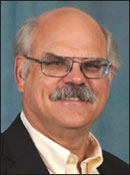Awardee Interviews | Biography: David Castner
David Castner
David Castner, University of Washington
“for leading advances in rigorous and state-of-the-art surface analysis methods applied to organic and biological samples”

David G. Castner is a Professor of Bioengineering and Chemical Engineering, the Director of the National ESCA and Surface Analysis Center for Biomedical Problems (NESAC/Bio), and the Director of the Molecular Analysis Facility at the University of Washington (UW). Prof. Castner received his Ph.D. in Physical Chemistry from University of California at Berkeley in 1979, where he studied small molecule chemisorption and reactivity on rhodium single crystal surfaces. He then spent seven years as a Research Chemist at the Chevron Research Company developing XPS and XAS methods for characterizing heterogeneous catalysts before moving to the UW in 1986 to pursue research in biomedical surface analysis. He was also the Director of the UW Center for Nanotechnology (2004–2005) and the Associate Dean of Engineering for Infrastructure (2009–2012). He has been a Guest Professor at the University of Paris since 2003. Prof. Castner is a Fellow of AVS, Biomaterials Science and Engineering, and American Institute for Medical & Biological Engineering. Prof. Castner received the 2003 Excellence in Surface Science Award from the Surfaces in Biomaterials Foundation, the 2004 Clemson Award for Basic Research from the Society of Biomaterials, the 2014 Rivière Prize from the UK Surface Analysis Forum, and the 2017 ECASIA Award. He was AVS President in 2010 and became an AVS Honorary Member in 2013.
Prof. Castner has an active research program in the areas of surface analysis, surface modification, biomaterials, nanomaterials and organic thin films, co-authoring more than 250 refereed publications and giving more than 220 invited presentations. Over the past 40+ years his surface science/analysis research has covered a wide range of surface modification and characterization topics. Since arriving at the UW in 1986 his research has focused developing new surface analysis methods and using a multi-technique approach to provide detailed characterization of biomedical materials, ranging from implanted biomaterials to diagnostic devices, with a special emphasis on characterizing the interactions of biomolecules (peptides, proteins, DNA, etc.) and cells with biologically relevant surfaces and interfaces. His research has included numerous research collaborations at the UW and around the world, as well as managing multi-disciplinary research projects and teams. He has also been the general chair and program chair for international conferences such as SIMS and PacSurf.
In the 1990s his research focused on using a complementary, multi-technique approach (XPS, ToF-SIMS, NEXAFS, etc.) to determine the composition and structure of organic surfaces ranging from SAMs to RF glow discharge deposited films and relating that information to their biological performance. Since 2000 a major thrust of his research program has been to develop methods for characterizing surface bound proteins and peptides to determine their identity, amount, conformation, orientation and spatial distribution. This research has shown combining ToF-SIMS, multivariate analysis, XPS, NEXAFS, SFG, etc. with molecular dynamics and Monte Carlo simulations is a powerful approach for investigating the structure of surface bound proteins and peptides. In the past 10 years another major research thrust has been the development of surface analysis methods using XPS and TEM measurements in combination with Monte Carlo simulations to characterize the composition and structure of nanoparticles.